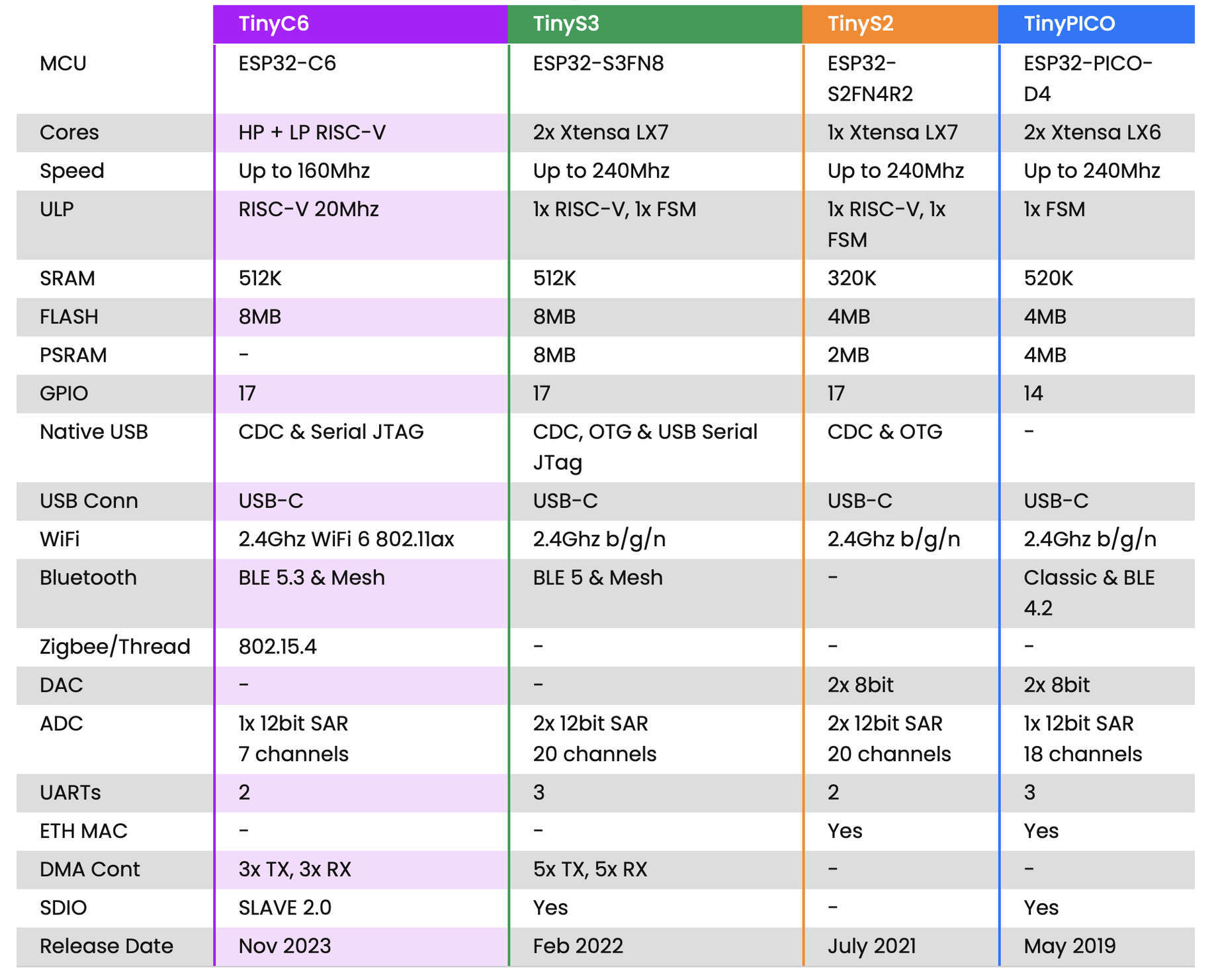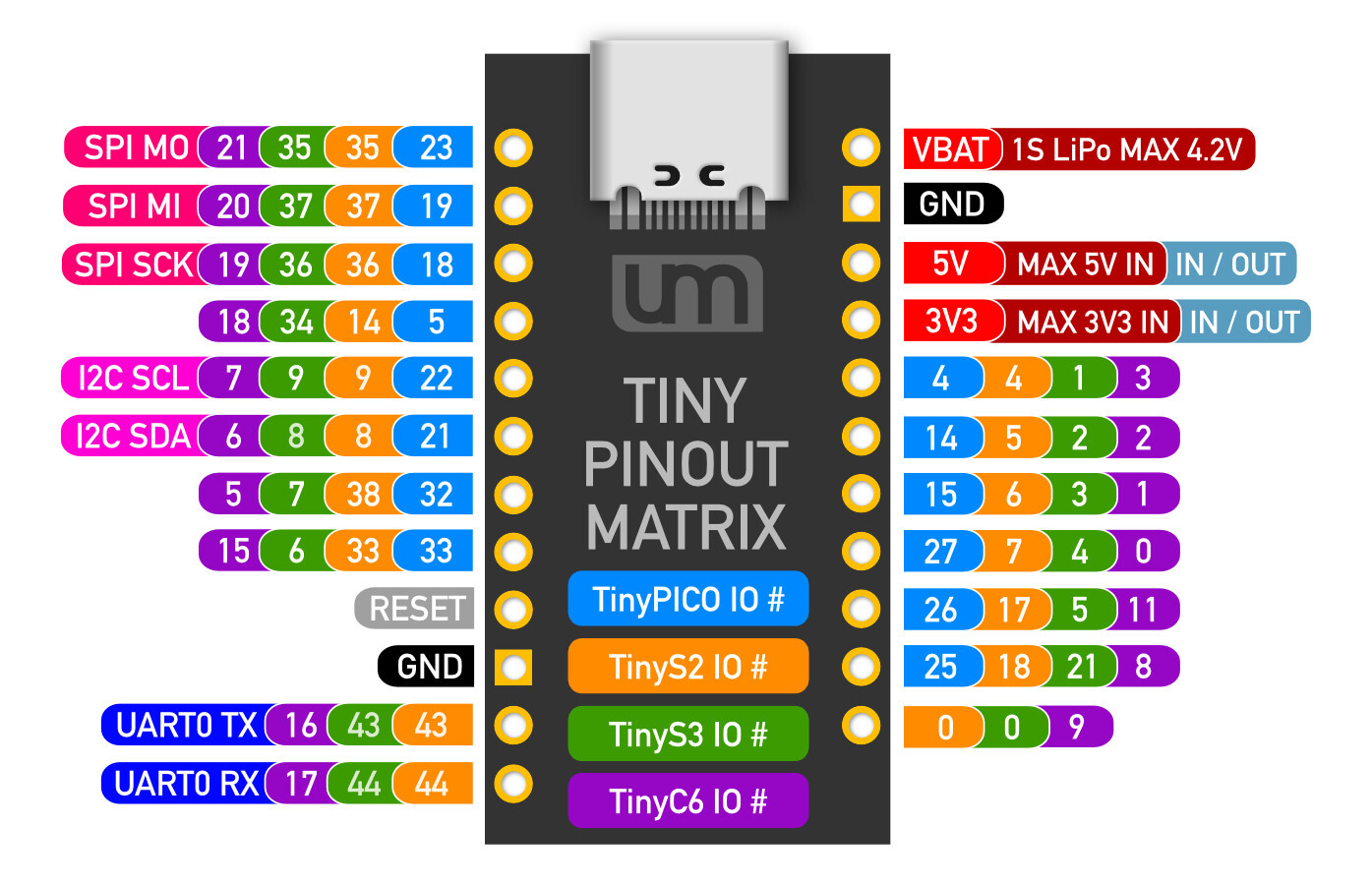TinyPICO V3
Sold by Unexpected Maker
$20.00
No tax for United States [change]
Volume discount | |
2+ items | $19.50 |
4+ items | $19.00 |
10+ items | $18.50 |
TinyPICO is a TINY, fully-featured ESP32 development board, designed to give you access to the power of the ESP32’s dual core 240 MHz processor and internet connectivity, all in a package smaller than your thumb!
Until you hold it in your hand, you really can’t appreciate just how small the TinyPICO is.
Features & Specifications
Processing:
- 32-bit dual-core processor operating at 240 MHz
- 4 MB SPI flash
- 4 MB extra PSRAM
Wireless:
- 2.4 GHz Wi-Fi - 802.11b/g/n
- Bluetooth Classic + BLE 4.2
- 3D high gain antenna
Power:
- 700 mA 3.3 V LDO regulator
- Optimised power path for low-power battery usage
- LiPo battery management
- Battery pads on the bottom support both JST PH & MicroBlade connectors (included unassembled with every TinyPICO)
- Power (red) & charge (orange) LEDs
Form-factor:
- Breadboard-friendly
- Oh, it’s tiny! Just 18 mm x 32 mm
Connectivity:
- 14x GPIO broken out to standard pitch headers
- All GPIO are 3.3V only
- USB for programming
- APA102 RGB LED
Control:
- MicroPython pre-installed
- Supports Arduino IDE
- Supports Espressif IDF
- Lots of example code and libraries

Development Platforms & Software Documentation
TinyPICO ships with mainline MicroPython pre-installed and supports Arduino IDE and Espressif IDF, so you have the flexibility to code the way you want.
I have been working hard behind the scenes on MicroPython and Arduino C++ helper libraries for TinyPICO as well as collecting and even writing MicroPython libraries for all the hardware we use on our shields.
I have basic coding examples on our TinyPICO website and all of our libraries are being added to the TinyPICO GitHub repository.
Optimised Power Paths & Deep Sleep Current
TinyPICO has been designed with two isolated power paths: a 5 V path and a 3.3 V path. Any components that are not needed for operation via battery or via the 3.3 V power pin are isolated within the 5 V power path, and are totally shut down when no USB cable is plugged in.
In-fact, even the power & charge LEDs are shutdown when no 5 V power source is present.
Deep sleep has been optimised for all development platforms, and though we have seen it go as low as 10 uA, our official current rating in deep sleep is 18 uA.
Note: TinyPICO includes an on-board APA102 RGB LED that has a quiescent current of 1 mA.
Thankfully we have a solution for deep sleep. GPIO13 controls the power to the APA102 using a PNP transistor via a high-side switch, so taking GPIO13 high shuts down power to the APA102. It’s essential to do this before going into deep sleep to ensure the lowest current draw possible.
In MicroPython, it’s also required to shutdown GPIO2 and GPIO12 (DATA and CLK for the APA102) as MicroPython uses IDLE HIGH as the default clock state, so you can get current leakage via the CLK or DATA, even with no power to the APA102 directly. We have created some helper functions for you in our TinyPICO MicroPython helper library to make this easy.
Tiny board comparison matrix
Pinout compatibility matrix
Package Contents
Each TinyPICO comes in an anti-static bag that includes:
- 1x TinyPICO
- 1x Set of male headers
- 1x JST PH connector
- 1x Printed pinout reference card
The headers and JST connector come loose, and require soldering if you plan to use them.
TinyPICO and Heat
The Espressif PICO-D4 is a very powerful SIP (System In a Package) for its size, and when running Wi-Fi continuously it gets hot, and because the TinyPICO is small, there is not a lot of place for heat to transfer to.
This is nothing to be alarmed about though. Even when running hot, everything is well within spec. It’s just something we wanted everyone to be aware of.
If you need to keep Wi-Fi active for long periods of time, like for a soft-ap setup, make sure you don’t enclose your TinyPICO in a small case that has no air flow, and maybe even consider adding a small heatsink to the board to help with heat transfer.
Find out more about what I do
Check out my youtube channel to see other projects I work on!
Links to code and documentation
Shipping policy
All products purchased on this store ship directly from me here in Melbourne, Australia.
Orders are processed daily and usually go out the same day they are paid for - allowing for time zone differences of course.
Finally, postage rates suck, sorry :( I'm embarrassed by how much it costs to ship items overseas since COVID, and I do my best to improve rates where I can.
Postage delivery times, if stated, are based on current expectations from Australia Post and may vary.
Please keep in mind that there are still occasional postage delays, including flights out of Australia and inbound customs processing into many countries.
The seller
I design and manufacture my own range of electronics products, mostly around micro-controllers, IOT and products that help with manufacturing.
I'm based in Melbourne, Australia, and all products are made by me and shipped from here to hobbyists, makers, companies and resellers around the world.




